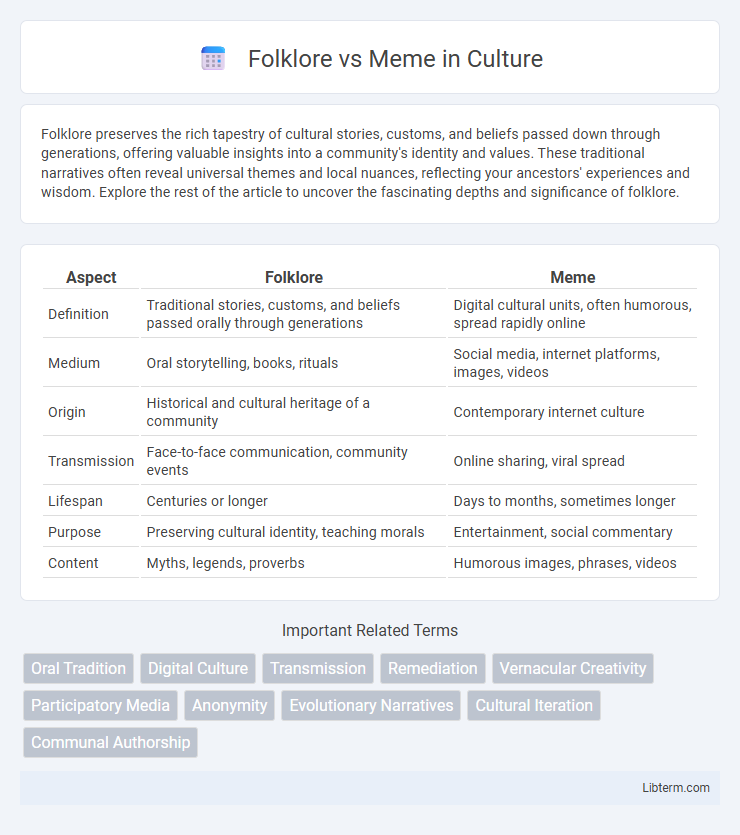Folklore preserves the rich tapestry of cultural stories, customs, and beliefs passed down through generations, offering valuable insights into a community's identity and values. These traditional narratives often reveal universal themes and local nuances, reflecting your ancestors' experiences and wisdom. Explore the rest of the article to uncover the fascinating depths and significance of folklore.
Table of Comparison
| Aspect | Folklore | Meme |
|---|---|---|
| Definition | Traditional stories, customs, and beliefs passed orally through generations | Digital cultural units, often humorous, spread rapidly online |
| Medium | Oral storytelling, books, rituals | Social media, internet platforms, images, videos |
| Origin | Historical and cultural heritage of a community | Contemporary internet culture |
| Transmission | Face-to-face communication, community events | Online sharing, viral spread |
| Lifespan | Centuries or longer | Days to months, sometimes longer |
| Purpose | Preserving cultural identity, teaching morals | Entertainment, social commentary |
| Content | Myths, legends, proverbs | Humorous images, phrases, videos |
Defining Folklore: Origins and Evolution
Folklore encompasses traditional beliefs, stories, customs, and cultural practices passed down through generations, originating from oral traditions dating back millennia. Its evolution reflects societal changes, adapting narratives and rituals to contemporary contexts while preserving historical identity. Unlike memes, which spread rapidly via digital platforms, folklore develops gradually within communities, embedding collective values and historical knowledge.
What Are Memes? Digital Culture Explained
Memes are units of cultural information that spread rapidly through the internet, often in the form of images, videos, or texts, reflecting humor, trends, and social commentary. Unlike traditional folklore, which evolves over generations through oral storytelling, memes are digital artifacts shaped by real-time global participation and viral sharing. This constant evolution within digital culture highlights memes as powerful tools for shaping contemporary social identity and communication.
Core Functions: Folklore vs Memes
Folklore serves as a cultural framework preserving traditional narratives, customs, and beliefs through oral transmission across generations, reinforcing community identity and shared values. Memes function as rapid, digital carriers of humorous or satirical content, facilitating social commentary and viral communication in online environments. Both modalities influence collective consciousness, but folklore emphasizes longevity and cultural continuity while memes prioritize immediacy and adaptability.
Transmission Methods: Oral Tradition vs Virality
Folklore primarily relies on oral tradition for transmission, where stories, customs, and beliefs are passed down verbally through generations, preserving cultural heritage and communal identity. Memes spread rapidly through digital platforms and social media, leveraging virality via shares, likes, and reposts to reach a global audience in real time. While folklore transmission is typically slow and localized, meme virality enables quick, widespread dissemination, often evolving and mutating with each iteration.
Cultural Significance and Impact
Folklore preserves traditional cultural narratives, values, and customs passed down through generations, shaping communal identity and collective memory. Memes, as digital cultural artifacts, rapidly disseminate contemporary ideas and humor, influencing social norms and communication in real time. Both serve as reflections of societal values, yet folklore roots cultural continuity, while memes drive cultural evolution and immediate social interaction.
Symbols and Storytelling: Comparing Structures
Folklore relies on traditional symbols and archetypal storytelling passed through generations, emphasizing cultural values and communal identity. Memes utilize contemporary symbols and rapid digital storytelling, often employing humor or satire to convey messages within internet subcultures. Both structures focus on symbolic representation, but folklore embodies longevity and shared heritage, while memes prioritize immediacy and viral engagement.
Community Participation in Folklore and Memes
Community participation in folklore involves the oral transmission of stories, customs, and traditions that embody collective cultural identity and values over generations, often evolving through face-to-face interactions. Memes rely on digital platforms where users rapidly create, share, and modify humorous or relatable content, fostering a decentralized and participatory culture driven by viral replication and remixing. Both folklore and memes thrive on communal engagement, but folklore emphasizes preservation and continuity, while memes prioritize immediate, dynamic interaction and adaptation.
Adaptation and Transformation Over Time
Folklore and memes both undergo continuous adaptation and transformation driven by cultural contexts and technological platforms. Folklore evolves through oral transmission and communal reinterpretation, preserving core narratives while allowing variations that reflect societal changes. Memes rapidly mutate through digital sharing and remixing, reflecting contemporary humor and social trends with immediacy and fluidity.
Authenticity and Authorship: Who Owns the Narrative?
Folklore embodies collective authorship, evolving anonymously through generations, reflecting communal values and cultural authenticity embedded in oral traditions. Memes, often originating from identifiable creators on digital platforms, highlight individual authorship and rapid modifications, challenging traditional notions of narrative ownership. This contrast raises critical questions about authenticity, as folklore's communal narrative resists commodification, while memes blur boundaries between personal creation and viral collective remixing.
The Future of Folklore in a Meme-Driven World
The future of folklore in a meme-driven world hinges on the dynamic adaptation of traditional narratives through digital platforms where memes serve as modern storytelling tools. As memes rapidly evolve, they encapsulate cultural values and social commentary, potentially transforming folklore into a more participatory and visually-driven form of collective memory. This fusion fosters a new digital folklore ecosystem where ancient myths and contemporary humor converge, ensuring cultural transmission amidst changing communication landscapes.
Folklore Infographic

 libterm.com
libterm.com